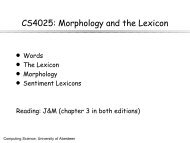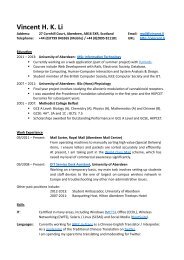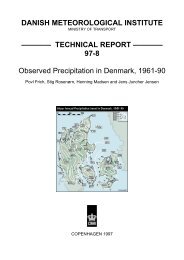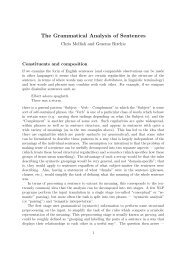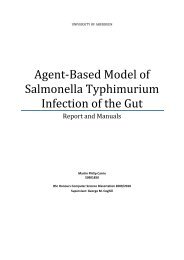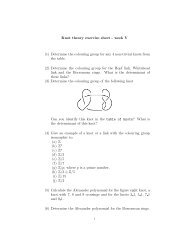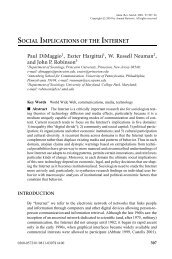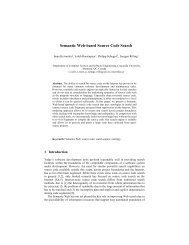Duncan Liddell monument - The University of Aberdeen
Duncan Liddell monument - The University of Aberdeen
Duncan Liddell monument - The University of Aberdeen
Create successful ePaper yourself
Turn your PDF publications into a flip-book with our unique Google optimized e-Paper software.
<strong>The</strong> Scientific Tourist: <strong>Aberdeen</strong><br />
<strong>Duncan</strong> <strong>Liddell</strong> – astronomical teacher, medic and benefactor <strong>of</strong> Marischal College<br />
<strong>Duncan</strong> <strong>Liddell</strong> MD (1561-1613) gains a place in these pages largely though his own wish to<br />
be remembered, though he does represent the scholarly Aberdonian who made a name for<br />
himself in Europe and did not forget his roots. <strong>Liddell</strong> (sometimes Liddel) left money to<br />
found the Chair <strong>of</strong> Mathematics at Marischal College under the patronage <strong>of</strong> the Town<br />
Council, he left money for bursaries that would enable poor students to attend the College, he<br />
donated his extensive library <strong>of</strong> books on Astronomy, Mathematics and Medicine along with<br />
his mathematical instruments to Marischal College, in addition to his estate, and he left<br />
money for the Town Council to erect a splendid memorial plaque in St Nicholas Church.<br />
Personally, he was never a student <strong>of</strong> Marischal College (it was founded when he was 32) nor<br />
a member <strong>of</strong> its staff. In return, a large ornamental granite memorial was erected by the<br />
Senatus in 1637 on his donated land near Dyce. <strong>The</strong> <strong>monument</strong> still stands today in excellent<br />
condition.<br />
His books, which are now some 400 years old, are an extremely valuable resource among the<br />
Historic Collections <strong>of</strong> the <strong>University</strong> Library and include a first edition <strong>of</strong> Copernicus’s De<br />
Revolutionibus, a copy <strong>of</strong> Copernicus’ very rare Commentariolus and other works from the<br />
very early years <strong>of</strong> modern astronomy.<br />
Much <strong>of</strong> the information available about <strong>Liddell</strong>’s life is repeated by a variety <strong>of</strong> sources. I<br />
have used the biography by David Irving in his 1839 ‘Lives <strong>of</strong> Scottish Writers’ 1 . <strong>Liddell</strong><br />
qualified for inclusion as a writer <strong>of</strong> well-respected medical books. <strong>The</strong>re is a lot we don’t<br />
know about <strong>Liddell</strong>’s life in spite <strong>of</strong> the range <strong>of</strong> sources cited in the Dictionary <strong>of</strong> National<br />
Biography 2 . We do know that he became Pr<strong>of</strong>essor <strong>of</strong> Mathematics in 1591 at Helmstädt<br />
<strong>University</strong> (founded in 1576 by the Duke <strong>of</strong> Brunswick as a Protestant <strong>University</strong> but which<br />
no longer exists) and that he taught astronomy as well as mathematics. He visited Tycho<br />
Brahe in Uraniborg on the island <strong>of</strong> Hven and was one <strong>of</strong> the early academics to teach<br />
Copernican astronomy in the version favoured by<br />
Brahe. This was a comparatively short-lived<br />
incarnation <strong>of</strong> the heliocentric view <strong>of</strong> the universe<br />
because Kepler’s laws <strong>of</strong> planetary motion formulated<br />
in the first quarter <strong>of</strong> the 17 th century would consign<br />
Brahe’s model to history. <strong>Liddell</strong> did not live to see this<br />
development. He kept his mathematical Chair until<br />
1603 but simultaneously had become a practising<br />
medic, indeed first physician at the court <strong>of</strong> Brunswick<br />
1/2
<strong>The</strong> Scientific Tourist: <strong>Aberdeen</strong><br />
and Pr<strong>of</strong>essor <strong>of</strong> Physic. It is likely that his medical practices were the foundation <strong>of</strong> the<br />
significant wealth he acquired.<br />
<strong>Liddell</strong> was born and brought up in <strong>Aberdeen</strong>. He left in 1579 aged about 18 to enlarge his<br />
education on the continent. He became well-known among the major European scholars <strong>of</strong><br />
the time but 28 years later he returned to <strong>Aberdeen</strong>, probably because <strong>of</strong> political and<br />
religious upheaval at Helmstädt. At <strong>Aberdeen</strong>, or at least within a few miles <strong>of</strong> <strong>Aberdeen</strong>, he<br />
lived on his estate at Pitmedden. It’s here that the <strong>Liddell</strong> <strong>monument</strong> can be found atop a<br />
prominent natural mound in a field. <strong>The</strong> simplest access route to the neighbourhood is via the<br />
road that goes past the Kirkhill Industrial Estate around Dyce airport. Park near a level<br />
crossing on a minor road. Cross the railway with care on foot and a rutted, muddy track<br />
leads to the even more muddy entrance <strong>of</strong> the field with the mound. Boots are highly<br />
desirable. <strong>The</strong> tall (over 5 m) and substantial obelisk, no longer fenced <strong>of</strong>f, is oriented with<br />
its faces to the four compass points. <strong>The</strong> east face includes a memorial panel with armorial<br />
shield over the motto ‘Sic Luceat Lux Vestra’ (thus shines your light); the south face a Latin<br />
inscription confirming the award <strong>of</strong> six bursaries for Pitmedden students to study at the<br />
<strong>University</strong>; the west face the city’s arms and motto ‘Bon Accord’ and the north face another<br />
Latin inscription noting that the <strong>monument</strong><br />
was erected in memory <strong>of</strong> <strong>Duncan</strong> Liddel<br />
(1561-1613) Rector <strong>of</strong> the Julian <strong>University</strong><br />
and Physician to the Court <strong>of</strong> Brunswick. <strong>The</strong><br />
ball on the top represents the celestial sphere,<br />
with the zodiac marked as a raised band.<br />
Much more accessible and indeed better<br />
known is the finely detailed brass plaque to<br />
<strong>Liddell</strong> in the West Church <strong>of</strong> St Nicholas near<br />
the centre <strong>of</strong> <strong>Aberdeen</strong>. <strong>The</strong> plaque was<br />
almost certainly designed by the notable<br />
Aberdonian painter George Jameson (fatherin-law<br />
<strong>of</strong> James Gregory, who features in one<br />
<strong>of</strong> these notes) and was cast in Amsterdam in<br />
1622, where Jameson had been resident<br />
beforehand. It is said to have cost 1400 marks,<br />
a large sum though I’m not quite sure how<br />
large in relation to typical wages <strong>of</strong> the time.<br />
<strong>The</strong> plaque is about 1.6 m tall and 0.9 m wide and one <strong>of</strong> only a handful <strong>of</strong> memorial brasses<br />
in Scotland 3 . <strong>The</strong> central image in the plaque is shown here.<br />
<strong>Liddell</strong>’s very generous donations to the newly formed Marischal College suggest that he saw<br />
it as <strong>Aberdeen</strong>’s equivalent <strong>of</strong> the protestant Helmstädt <strong>University</strong> that had been founded just<br />
17 years before Marischal College. He had seen how Helmstädt was already a progressive<br />
establishment not hampered by the weight <strong>of</strong> Papal bull and wished to see the similar vision<br />
<strong>of</strong> the Earl Marischal helped forward.<br />
John S. Reid<br />
1 David Irving “Lives <strong>of</strong> Scottish Writers” vol. 1, pp 275-291 (Adams & Charles Black, Edinburgh, 1839)<br />
2 Entry <strong>Duncan</strong> Liddel “Dictionary <strong>of</strong> National Biography” OUP, 2006<br />
3 Andrew Gibb “Notice <strong>of</strong> the Memorial Brass <strong>of</strong> Dr <strong>Duncan</strong> Liddel, and <strong>of</strong> the Tombstone <strong>of</strong> Sir Paul Menzies<br />
<strong>of</strong> Kinmundy, in Saint Nicholas Church, <strong>Aberdeen</strong>” Proceedings <strong>of</strong> the Society <strong>of</strong> Antiquities <strong>of</strong> Scotland, vol.<br />
XI, pp 450-462 (1876).<br />
2/2



